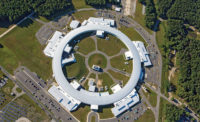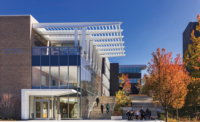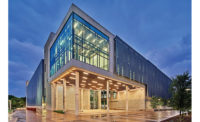Upton, N.Y.
Region New York
Project Team
General Contractor Torcon Inc.
Owner/Developer Brookhaven National Laboratory
Lead Design Firm HDR
The best light show in the U.S. isn’t in Las Vegas or Times Square; it’s about 67 miles east of the intersection of Broadway and 42nd Street in the Long Island hamlet of Upton, N.Y., at the Brookhaven National Laboratory. But would-be viewers will be barred unless they’re one of up to 4,000 scientists who will use the world’s brightest light beams inside the new National Synchrotron Light Source-II facility (NSLS-II) to “unearth details at the micro and nano levels and watch, in real time, chemical and electronic processes that take place at the atomic scale,” says the project team in its ENR Best of the Best submission.
The $912-million facility, completed last year at the federal research site after seven years of development, was sponsored by U.S. Energy Dept. R&D funding to spur new energy technologies, among other advances in medicine and environmental science. The NSLS-II’s X-ray, ultraviolet and infrared light beams will be 10,000 times brighter than at its predecessor facility, which is being decommissioned after about 30 years of operation.
Despite the ultra-precise requirements of its nano-scale mission, NSLS-II was built to house 826 high-precision magnets to accelerate a beam of electrons around a concrete tunnel, or storage ring, at 99% the speed of light. It is nearly a half-mile in circumference—large enough to encircle Yankee Stadium.
DOE’s goal for NSLS-II was to “push the envelope of technical capability to levels not previously achieved by other synchrotron light sources around the world,” says Martin Fallier, Brookhaven division director of photon sciences. “Expectations for performance and capability were very high from the start, and this project would have to be extremely innovative to achieve demanding technical goals, such as resolution to just 1 nanometer—a billionth of a meter—enabling visualization at the atomic scale.”
For such a unique facility, the building team “couldn’t just design a warehouse,” says Ahmed Soueid, senior vice president of lead design firm HDR. “We had to really understand the machine.” Team members worked closely with the scientific community at Brookhaven to design the ring and its surrounding building.
“I learned a lot about the science of building and designing synchrotrons, and I was able to be an advocate for the scientists,” Soueid points out. “We, as architects, had to get into their heads and understand how they make decisions, and they had to understand [our process.]”
Designers created computer models to give the facility the precise design needed, with the beam-line as the focal point. The models were used to determine the thickness of the concrete slab below the beam-line and throughout the facility, the advantages of a structurally monolithic concrete pour, the machine-room locations, and what types of pumps and fans to install, according to the project team.
“The challenge of building NSLS-II “was the need to coordinate the work of three technical divisions designing state-of-the art capabilities under a demanding schedule,” says Fallier. “The conventional facilities needed to be designed and constructed first, but requirements … were dependent on the design of the accelerator systems that produced the intense X-rays.”
The models allowed the team to test vibration-isolating features to ensure the light beam was rock-steady. By studying the correct depth levels for the footings needed to dissipate vibrations, team members designed a structure that does not vibrate more than 25 nanometers in any direction. It also controls temperature fluctuations to within 0.1° C.
“We studied the geometry of the machine and developed a structural grid, with column lines angled at three degrees apart,” explains Soueid. “This mirrors the angle of the accelerator beam-line as it bends, while passing the various magnets in the storage tunnel. The geometry of the conventional facilities mirrors that of the accelerator.”
To ease this process, the team settled on a simple design that would allow the storage ring to be built in five identical segments, each containing a lab office building, service building and storage ring. As each segment was finished, Brookhaven could install the beam-line magnets. “It may not look glamorous, but it’s very creative,” Soueid says of the complex’s final design.
The design also allowed for easier construction and the longest possible life span for the facility. If a problem arises in one building segment, the other four can compensate.
To eliminate settling that could affect beam-lines, NSLS-II builders placed compacted structural sand 10 ft below the surface of the ring building’s footprint. “The more traditional approach of driving piles into the earth for building stability was not a viable option for NSLS-II due to the vibration it would produce,” says the team. Service buildings inside the ring have structurally supported floors, also to cut vibrations.
Builders poured a total of 41,000 cu yd of concrete to form the 27-in. slabs, up to 39-in.-thick walls and the 32-in.-thick ceiling that make up the accelerator tunnel.
The team also was able to maximize efficiency by phasing the work; for example, crews built temporary walls to separate finished areas from those still under construction, allowing scientific work to begin ahead of schedule.
The project’s ring structure, as well as lab and office buildings, achieved LEED Gold certification. The site includes 30 acres of open green space, and cooling towers reduce central-plant cooling energy consumption by about 1.2 megawatts annually.
A Science magazine article in February says engineers plan to add 25 more beam-lines over the next five years to the first seven now there, with expected funding from DOE, the National Institutes of Health and other agencies. NSLS-II may ultimately have up to 70 beam-lines that will be used to study high-temperature superconductors, next-generation silicon chips and biological proteins “on the smallest scales,” says Science.









